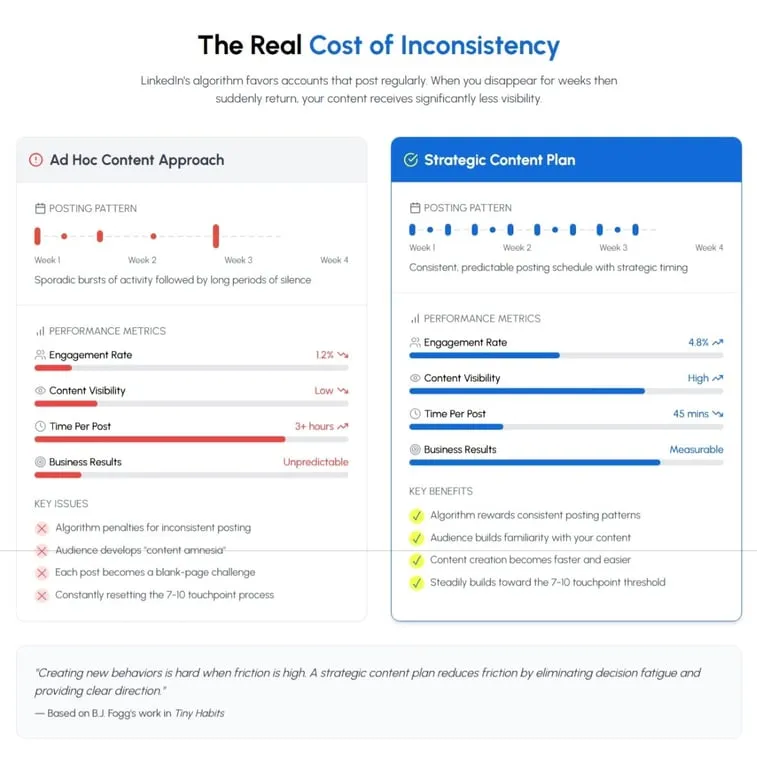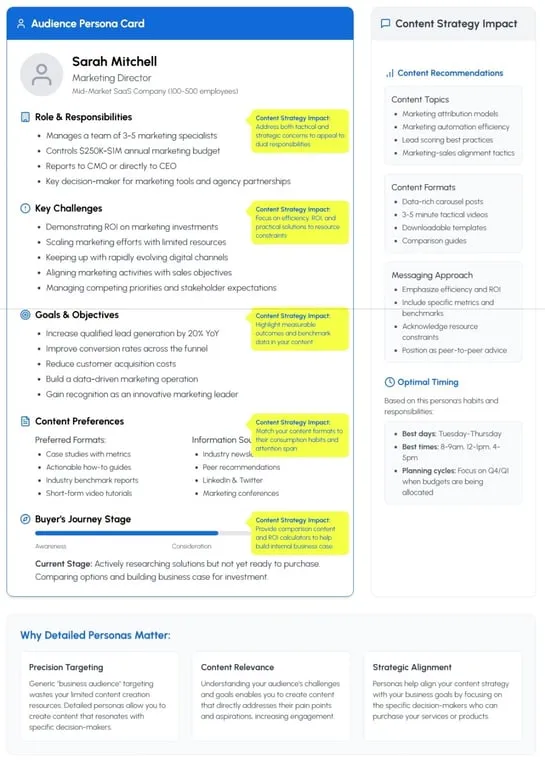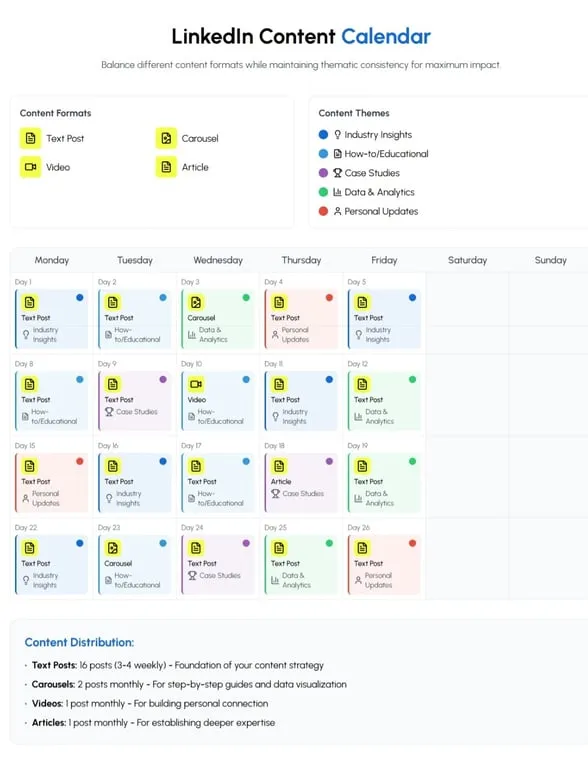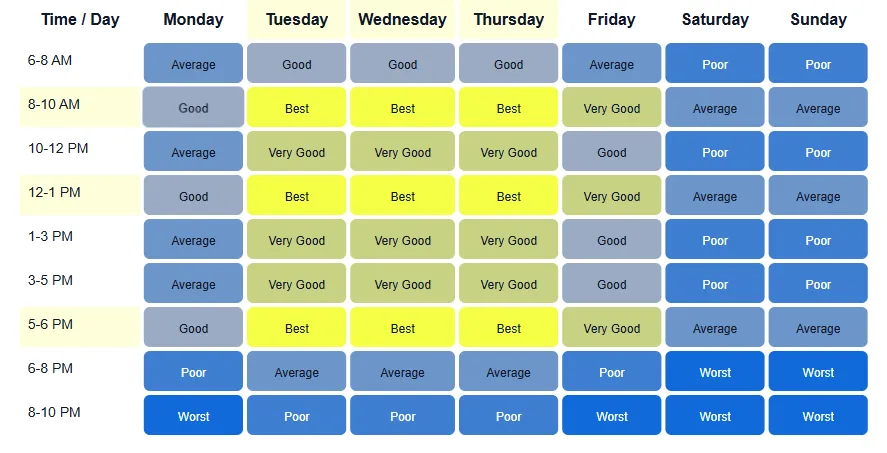"I don't have time to post on LinkedIn."
I hear this from agency owners and founders almost daily. And I get it-between client work, team management, and business development, LinkedIn often falls to the bottom of your priority list.
But here's what's fascinating: The most successful agency owners I know aren't necessarily working harder on LinkedIn-they're working smarter with a structured content plan.
According to LinkedIn's own data, companies posting weekly see engagement rates twice as high as those posting monthly. For agencies specifically, LinkedIn generates 80% of B2B social media leads, making it too valuable to approach haphazardly.
This guide will walk you through creating a LinkedIn content strategy that delivers meaningful results without consuming all your time. Let's transform your LinkedIn presence from a sporadic activity into a strategic business asset.
Why You Need a LinkedIn Content Plan
Most agency owners approach LinkedIn reactively-posting when inspiration strikes or when they finally remember it's been weeks since their last update. This inconsistency undermines your potential results in several ways.
The Real Cost of Inconsistency
LinkedIn's algorithm favors accounts that post regularly. When you disappear for weeks then suddenly return, your content receives significantly less visibility. But the costs extend beyond algorithm penalties:
Your audience develops "content amnesia" when your messaging lacks cohesion. Research from the Content Marketing Institute shows that B2B decision-makers need 7-10 touchpoints before considering a service provider. Without consistent presence, you reset this process repeatedly.
Content creation itself becomes more time-consuming without a framework. Each post becomes a blank-page challenge rather than executing a proven system. As Stanford psychologist B.J. Fogg explains in his book Tiny Habits, "Creating new behaviors is hard when friction is high."

The Business Impact of Strategic Content
For agencies specifically, LinkedIn content directly influences business development. According to Gong's research, prospects who engage with your content before receiving outreach are 25% more likely to respond and 13% more likely to accept meetings.
More compelling still, Edelman's B2B Thought Leadership Impact Study found that 42% of decision-makers would pay a premium to work with firms that produce consistent thought leadership content. Your LinkedIn presence doesn't just generate awareness-it can directly influence pricing power.
Step 1: Define Your Content Strategy Foundation
Before you write a single post, you need to establish the strategic foundation for your LinkedIn content. This foundation makes every content decision easier and more effective.
Clarify Your Content Goals
Most agency owners make the mistake of posting without clear objectives. Start by identifying what specific outcomes you want your LinkedIn content to achieve:
Brand awareness and visibility: Expanding your reach to new potential clients and partners.
Thought leadership positioning: Establishing your agency's distinctive expertise and perspective.
Lead generation: Creating interest that converts to inquiries and consultations.
Relationship nurturing: Deepening connections with existing prospects and clients.
Talent attraction: Showcasing your agency culture and opportunities.
While your content may serve multiple objectives, prioritize 2-3 primary goals based on your current business needs. Are you focusing on new client acquisition or maximizing existing client relationships? Are you actively hiring or concentrating on your current team's productivity?
The managing partner of a cybersecurity agency I worked with realized that 80% of their growth came from existing client expansions rather than new logos. This insight shifted their content strategy to focus heavily on educational content that highlighted additional service areas, resulting in a 34% increase in existing client upgrades.
Define Your Target Audience
LinkedIn offers unprecedented targeting precision, but only if you've clearly defined who you're trying to reach. Generic "business audience" targeting wastes your limited content creation resources.
Develop detailed audience personas that address:
Decision-making roles: Who holds budgetary authority for your services? Who influences these decisions? What functional areas do they represent?
Industry contexts: What sectors do they work in? How do industry dynamics affect their challenges?
Professional challenges: What keeps them awake at night? What objectives are they responsible for achieving?
Information habits: Where do they currently get professional insights? What content formats do they prefer?
For example, a marketing agency might distinguish between CMOs at enterprise companies (concerned with organizational alignment and board-level reporting) versus marketing directors at mid-market companies (focused on tactical execution and resource maximization).

Establish Your Content Pillars
Content pillars are the foundational topics that align with your expertise and audience needs. These pillars create cohesion in your content while establishing your distinctive positioning.
For agency owners, effective content pillars typically include:
Core service areas: Topics directly connected to your primary offerings and methodologies.
Client challenges: Common problems your ideal clients face (which your services help solve).
Industry insights: Perspectives on trends and changes affecting your target market.
Proof points: Approaches for demonstrating results and impact.
Select 3-5 main pillars that will form the backbone of your content. For instance, a web development agency might choose: modern frontend frameworks, UX design principles, performance optimization, and client collaboration processes.
LiGo's content themes feature can streamline this process by analyzing your professional background and suggesting personalized themes that resonate with your target audience.
Step 2: Develop Your Content Mix
With your foundation established, you need to create a balanced content mix that maintains audience interest while serving different strategic purposes.
Strategic Content Types
Different content types serve distinct objectives in your overall strategy:
Educational content builds authority by addressing specific knowledge gaps. A detailed post explaining "How to Interpret Google Analytics 4 for E-commerce Businesses" positions your agency as helpful experts rather than sales-focused vendors.
Thought leadership content establishes unique positioning through distinctive perspectives. Taking a clear position on industry debates or challenging conventional wisdom differentiates your agency in crowded markets.
Social proof content builds credibility through results and testimonials. Showcasing specific client outcomes (with permission) provides evidence that supports your claims.
Behind-the-scenes content humanizes your agency by showing your team, culture, and processes. This content builds connection and often performs surprisingly well on engagement metrics.
Curated insights demonstrate your industry awareness by sharing valuable content with your added perspective. This approach builds goodwill while requiring less creation time.
The most effective mix typically includes elements from all these categories rather than overrelying on any single approach. Our research on LinkedIn post ideas provides specific examples of each content type with performance data.
Content Format Diversity
LinkedIn rewards format diversity, and different formats serve distinct purposes:
Text posts form the foundation of most strategies due to their high engagement-to-effort ratio. Our analysis of high-performing text posts shows optimal length between 1,200-1,500 characters-just under LinkedIn's "see more" threshold.
Document carousels drive 3x higher engagement than standard posts according to LinkedIn's own data. They're ideal for step-by-step processes, data visualization, or multi-point arguments.
Native video creates stronger personal connection through facial expressions and voice. LinkedIn reports videos under 3 minutes perform best for most business content.
LinkedIn articles establish deeper expertise and perform better for SEO visibility. While they typically receive less feed engagement, they create lasting value and can be referenced in your other content.
For most agency owners, I recommend starting with 2-3 formats you can execute consistently before expanding. Our guide to LinkedIn post formats provides detailed examples of each format with optimization tips.
The Value-Promotion Balance
The most successful LinkedIn strategies follow a clear content ratio:
80% value-focused: Educational, informative, or entertaining content that helps your audience without asking for anything in return.
20% promotion-focused: Content that directly highlights your services, capabilities, or opportunities.
This balance ensures you're building goodwill and authority before introducing promotional elements. As LinkedIn expert Justin Welsh notes, "Give value 5x before making a single ask."
Step 3: Create Your Content Calendar
A structured calendar transforms your strategy into an actionable plan that eliminates daily decision fatigue.
Sustainable Posting Frequency
The optimal posting frequency depends on your growth stage and capacity:
Building phase (0-1,000 followers): Focus on quality over quantity with 2-3 posts weekly.
Growth phase (1,000-5,000 followers): Increase to 3-4 times weekly to maximize algorithm visibility.
Scaling phase (5,000+ followers): Consider 4-5 posts weekly for comprehensive coverage.
However, consistency matters more than frequency. A reliable twice-weekly posting schedule outperforms sporadic daily posting. Choose a cadence you can maintain consistently even during busy periods.

Content Themes and Rhythms
Creating a predictable pattern for different content types makes planning easier and helps your audience know what to expect:
Monday: Industry insights or weekly planning topics to start the week Tuesday: Educational how-to content addressing specific challenges Wednesday: Case studies or success stories demonstrating impact Thursday: Thought leadership perspectives on industry evolution Friday: Engagement-focused content or weekly reflections
This approach creates natural content variety while simplifying your planning process. For deeper insights into optimal posting timing, our research on best times to post on LinkedIn provides industry-specific recommendations.
Monthly Theme Planning
Organizing your content around monthly themes creates stronger narrative cohesion while simplifying your planning:
Align with business cycles: Focus on planning content in November, implementation topics in January, and measurement frameworks in March.
Connect to industry events: Create content related to major conferences or releases in your industry.
Address seasonal challenges: Anticipate your clients' cyclical needs with timely content.
For example, a marketing agency might focus on "Attribution Models" in January when clients are establishing annual measurement frameworks, then shift to "Creative Strategy" in Q2 as clients prepare summer campaigns.
Using LiGo's content calendar features, you can plan these themes in advance and generate specific post ideas aligned with each theme.
Step 4: Develop Your Content Creation Process
Without an efficient creation process, even the best content plan will falter during busy periods. The key is establishing systems that maintain quality while minimizing time investment.
Content Batching System
Rather than creating posts daily, implement a batching approach:
-
Block 2-3 hours weekly (ideally the same time each week)
-
Create 1-2 weeks of content in each session
-
Draft posts in a document before transferring to LinkedIn
-
Schedule distribution using LinkedIn's native scheduler or third-party tools
This approach typically reduces total creation time by 30-40% by eliminating context switching costs. As Cal Newport demonstrates in his deep work research, concentrated effort produces higher quality results with lower time investment.
Content Repurposing Strategy
The most efficient content creators leverage existing material rather than constantly generating new ideas:
Client deliverables: Transform sections of client presentations into educational posts (removing confidential information).
Team meetings: Extract insights from internal discussions for thought leadership content.
Client questions: Document common questions and concerns as the basis for educational posts.
Speaking engagements: Break presentations into multiple LinkedIn posts.
Aim to generate at least 3-5 LinkedIn posts from each major content piece you create elsewhere in your business. This approach dramatically reduces creation time while ensuring relevance to your audience.
Template-Based Creation
Developing templates for recurring content types eliminates starting from scratch each time:
Case study format: Challenge → Approach → Results → Key Learnings
How-to structure: Problem → Solution Steps → Implementation Tips → Results Possible
Industry analysis framework: Trend → Implications → Predictions → Strategic Responses
These templates reduce decision fatigue and ensure consistent quality across your content. For example, our LinkedIn post formatting guide provides tested templates for various content types.
LiGo streamlines this process further by generating customized content based on your established themes, saving valuable time while maintaining your authentic voice.
Step 5: Optimize for Engagement
Strategic engagement approaches amplify your content's reach and impact far beyond your direct follower count.
Writing for the LinkedIn Algorithm
LinkedIn's algorithm favors content that generates meaningful conversation. Incorporate these elements to improve algorithmic performance:
Compelling hooks: The first 1-2 lines determine whether someone clicks "see more" or scrolls past. Start with a provocative question, surprising statistic, or counter-intuitive statement.
Native content: LinkedIn prioritizes content that keeps users on the platform rather than sending them elsewhere. Save external links for the first comment rather than the main post.
Conversation starters: End posts with specific questions that invite thoughtful responses rather than yes/no answers.
Response strategy: The first hour after posting significantly impacts algorithmic distribution. Block 15 minutes after posting to respond to early commenters.
Our guide on how to craft LinkedIn posts that get seen by your ideal clients provides a deeper analysis of algorithm optimization.
Strategic Timing Approaches
Post when your audience is most likely to engage:
Analyze your specific audience: Use LinkedIn analytics to identify when your particular followers are most active.
Test different windows: Experiment with varying posting times and track engagement patterns.
Consider industry patterns: Different professional sectors have distinct LinkedIn usage patterns.
The HubSpot Social Media Research Team found that Tuesday through Thursday between 9am-2pm typically performs best for B2B content, but your specific audience may differ.

Engagement Acceleration Tactics
Implement these approaches to boost initial engagement:
Internal engagement team: Notify select team members when important posts go live to jumpstart engagement.
Engagement pods: Consider joining or creating strategic engagement groups with complementary professionals.
Thoughtful tagging: Mention individuals who inspired your content or whose perspectives would add value (without excessive tagging).
Conversation nurturing: Respond to every comment with thoughtful replies that advance the discussion rather than simple acknowledgments.
Step 6: Measure and Optimize
Regular analysis helps refine your content plan for better results over time.
Performance Metrics That Matter
Track these metrics based on your primary goals:
Visibility metrics: Impressions, reach, and follower growth indicate awareness expansion.
Engagement metrics: Comments, shares, and engagement rate show content resonance.
Conversion metrics: Profile visits, connection requests, and direct messages represent interest progression.
Business impact metrics: Actual inquiries, meetings booked, and proposals sent demonstrate real business outcomes.
LiGo's analytics dashboard helps track these metrics and identify patterns in your highest-performing content themes and formats.
Monthly Content Audit Process
Conduct a structured review monthly:
-
Identify your top 5 performing posts based on engagement rate
-
Analyze common elements in topic, format, hook style, and posting time
-
Review underperforming content for improvement opportunities
-
Adjust your upcoming content mix based on performance patterns
Our guide on how to use analytics to improve your LinkedIn content strategy provides a detailed framework for this analysis.
Quarterly Strategy Refinement
Every three months, assess your overall content approach:
-
Evaluate progress toward your primary business goals
-
Review audience growth and engagement trends
-
Analyze which content themes generated actual business results
-
Adjust your content pillars based on market evolution
-
Set specific targets for the upcoming quarter
This quarterly review ensures your content strategy evolves with your business objectives and market conditions rather than becoming stale.
Step 7: Scale and Systematize
As your LinkedIn presence grows, implement systems to maintain quality while expanding your impact.
Team Involvement Approaches
Leverage your team to expand your content capacity:
Subject matter experts: Assign specific content pillars to team specialists who can provide unique insights.
Content submission system: Create a simple process for team members to contribute ideas and insights.
Approval workflow: Implement content review stages that maintain quality while distributing the workload.
One agency owner I work with reduced his personal content creation time by 70% by implementing a simple Slack channel where team members share client insights and project takeaways as raw material for LinkedIn content.
Content Curation Framework
Supplement original content with strategic curation:
-
Identify 10-15 authoritative sources in your industry
-
Create a weekly review process for finding valuable content
-
Add your unique perspective when sharing rather than simply reposting
-
Tag original creators to build relationships with industry thought leaders
Effective curation demonstrates your industry awareness while requiring less creation time than fully original content.
Automation and Tools
Implement tools to streamline your LinkedIn content process:
Content planning: Use LiGo's theme-based content generation to develop ideas aligned with your strategy.
Scheduling tools: Maintain posting consistency even during busy periods through advance scheduling.
Analytics platforms: Gain deeper insights into content performance patterns.
Design resources: Create consistent visual content that reinforces your brand identity.
The right tools can reduce your time investment while improving content quality and consistency.
Overcoming Common Content Planning Challenges
Even with a solid strategy, you'll likely encounter obstacles in your LinkedIn content journey. Here's how to address the most common challenges.
Finding Time for Consistent Content
The time constraint is the #1 challenge I hear from agency owners. Implement these practical solutions:
Block time on your calendar: Treat content creation as a non-negotiable appointment, ideally when your energy levels align with creative work.
Create monthly content sprints: Dedicate a half-day each month to developing multiple pieces rather than spreading the work throughout the month.
Build a content bank: Develop "evergreen" posts that remain relevant over time, creating a reserve for busy periods.
Start with a sustainable frequency: It's better to post consistently twice weekly than sporadically aim for daily content.
Using LiGo's content creation tools, you can reduce the time required to generate quality content while maintaining your authentic voice and expertise.
Maintaining Creativity and Avoiding Repetition
Content staleness becomes a legitimate concern over time. Address it with these approaches:
Document inspiration sources: Keep a running collection of content ideas, interesting perspectives, and client questions.
Create diverse content series: Develop multiple content themes that you can rotate between to maintain freshness.
Refresh your perspective: Schedule regular conversations with clients, team members, and partners specifically to gather new insights.
Analyze competitors and adjacent spaces: Study content from related industries for fresh approaches you can adapt.
Converting Content to Business Results
Ultimately, your LinkedIn content needs to drive business outcomes. Strengthen this connection through:
Strategic calls-to-action: Include subtle next steps in approximately 20% of your content.
Engagement nurturing system: Develop a process for converting commenters to connections and eventually to conversations.
Content-offer alignment: Create specific content series that naturally lead to your service offerings.
Visibility with current clients: Ensure your existing clients see content related to services they haven't yet purchased from you.
Our guide on how to create a LinkedIn strategy that generates inbound leads explores these conversion strategies in greater depth.
Conclusion: From Plan to Results
A well-structured LinkedIn content plan transforms sporadic posting into strategic communication that builds your authority, attracts ideal clients, and generates business opportunities. The key is creating a system that's both effective and sustainable for your schedule as an agency owner.
Remember that LinkedIn content success comes from consistency over time rather than viral moments. The compound effect of regular, valuable content creates a sustainable advantage that your competitors can't easily replicate.
Start by defining your foundation, creating a manageable calendar, and committing to consistent execution. Then measure, refine, and scale your efforts as you see results. With patience and persistence, your LinkedIn content plan will become a predictable system for growing your agency's visibility and attracting ideal clients.
For busy agency owners, tools like LiGo can dramatically streamline this process by generating content ideas aligned with your strategy, suggesting optimal posting times, and providing analytics to refine your approach over time.
Related Resources
-
Creating Your LinkedIn Content Theme: The Strategic Foundation for Consistent Growth
-
25 High-Impact LinkedIn Post Ideas That Drive Engagement in 2025
-
How to Schedule LinkedIn Posts: The Complete Guide for Busy Professionals
-
7 LinkedIn Post Formats Proven to Increase Engagement (With Examples)
-
LinkedIn Analytics: A Complete Guide to Measuring Your Success




